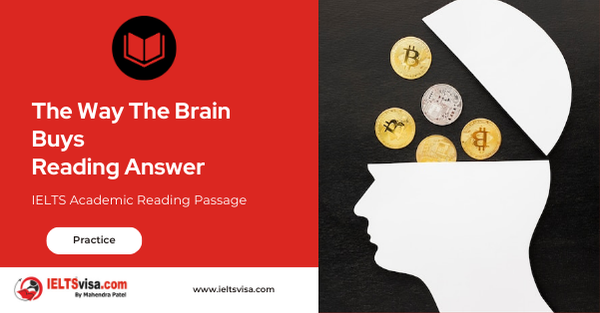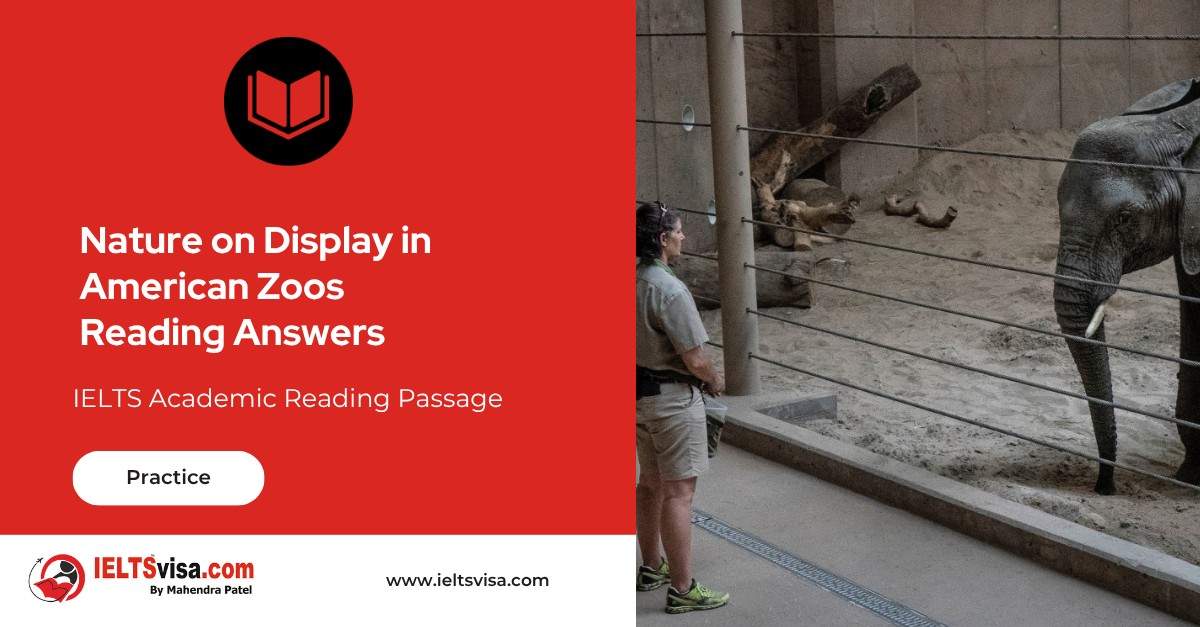The Way The Brain Buys Reading Answer
IELTS Academic Reading Passage
Supermarkets take great care over the way the goods they sell are arranged. This is because they know a lot about how to persuade people to buy things.
When yon enter a supermarket, it takes some time for the mind to get into a shopping mode. This is why the area immediately inside the entrance of a supermarket is known as the ‘decompression zone’. People need to slow down and take stock of the surroundings, even if they are regulars. Supermarkets do not expect to sell much here, so it tends to be used more for promotion. So the large items piled up here are designed to suggest that there are bargains further inside the store, and shoppers are not necessarily expected to buy them. Walmart, the world’s biggest retailer, famously employs ‘greeters’ at the entrance to its stores. A friendly welcome is said to cut shoplifting. It is harder to steal from nice people.
Immediately to the left in many supermarkets is a ‘chill zone’, where customers can enjoy browsing magazines, books and DVDs. This is intended to tempt unplanned purchases and slow customers down. But people who just want to do their shopping quickly will keep walking ahead, and the first thing they come to is the fresh fruit and vegetables section. However, for shoppers, this makes no sense. Fruit and vegetables can be easily damaged, so they should be bought at the end, not the beginning, of a shopping trip. But psychology is at work here: selecting these items makes people feel good, so they feel less guilty about reaching for less healthy food later on.
Shoppers already know that everyday items, like milk, arc invariably placed towards the back of a store to provide more opportunity to tempt customers to buy things which are not on their shopping list. This is why pharmacies are also generally at the back. But supermarkets know shoppers know this, so they use other tricks, like placing popular items halfway along a section so that people have to walk all along the aisle looking for them. The idea is to boost ‘dwell time’: the length of time people spend in a store.
Having walked to the end of the fruit-and-vegetable aisle, shoppers arrive at counters of prepared food, the fishmonger, the butcher and the deli. Then there is the in-store bakery, which can be smelt before it is seen. Even small supermarkets now use in store bakeries. Mostly these bake pre-prepared items and frozen ingredients which have been delivered to the supermarket previously, and their numbers have increased, even though central bakeries that deliver to a number of stores are much more efficient. They do it for the smell of freshly baked bread, which arouses people’s appetites and thus encourages them to purchase not just bread but also other food, including ready meals.
Retailers and producers talk a lot about the ‘moment of truth’. This is not a philosophical idea, but the point when people standing in the aisle decide to buy something and reach to get it. At the instant coffee section, for example, branded products from the big producers are arranged at eye level while cheaper ones are lower down, along with the supermarket’s own label products.
But shelf positioning is fiercely fought over, not just by those trying to sell goods, but also by those arguing over how best to manipulate shoppers. While many stores reckon eye level is the top spot, some think a little higher is better. Others think goods displayed at the end of aisles sell the most because they have the greatest visibility. To be on the right-hand side of an eye-level selection is often considered the very best place, because most people are right-handed and most people’s eyes drift rightwards. Some supermarkets reserve that for their most expensive own-label goods.
Scott Bearse, a retail expert with Deloitte Consulting in Boston, Massachusetts, has led projects observing and questioning tens of thousands of customers about how they feel about shopping. People say they leave shops empty- handed more often because they are ‘unable to decide’ than because prices are too high, says Mr Bearse. Getting customers to try something is one of the best ways of getting them to buy, adds Mr Bearse. Deloitte found that customers who use fitting rooms in order to try on clothes buy the product they are considering at a rate of 8j% compared with 58% for those that do not do so.
Often a customer struggling to decide which of two items is best ends up not buying either. In order to avoid a situation where a customer decides not to buy either product, a third ‘decoy’ item, which is not quite as good as the other two, is placed beside them to make the choice easier and more pleasurable. Happier customers are more likely to buy.
adapted from The Economis
Questions 1-4
Label the diagram below.
Choose NO MORE THAN THREE WORDS from the passage for each answer.
Layout of typical supermarket
1…………………
2…………………
3…………………
4…………………
Questions 5-10
Do the following statements agree with the information given in the reading passage? Write
TRUE if the statement agrees with the information FALSE if the statement contradicts the information NOT GIVEN if there is no information on this
5. The ‘greeters’ at Walmart increase sales.
6. People feel better about their shopping if they buy fruit and vegetables before they buy other food.
7. In-store bakeries produce a wider range of products than central bakeries.
8. Supermarkets find right-handed people easier to persuade than left-handed people.
9. The most frequent reason for leaving shops without buying something is price.
10. ‘Decoy’ items are products which the store expects customers to choose.
Questions 11-13
Complete the flow chart below.
Choose NO MORE THAN TWO WORDS from the passage for each answer.
In-store bread production process |
The supermarket is sent 11……………….. and other items which have been prepared earlier. |
|
Baking bread in-store produces an aroma.
|
Shoppers’ 12……………………. are stimulated. |
|
They are then keener to buy food, including bread and 13………………………
|

Solution For: The Way The Brain Buys Reading Answer
| 1. promotion | 8. NOT GIVEN |
| 2. unplanned purchases | 9. FALSE |
| 3. fruit and vegetables | 10. FALSE |
| 4. popular items | 11. frozen ingredients |
| 5. NOT GIVEN | 12. appetites |
| 6. TRUE | 13. ready meals |
| 7. NOT GIVEN |
Review and Practice
- Regularly practice with IELTS reading samples and time yourself to get used to the pressure of the exam.
- Review your mistakes to understand where you went wrong and how to avoid similar errors in the future.
Our Books
Master IELTS Speaking Part 1
IELTS Writing Task 1 Book
IELTS Writing Task 2 Book
The Way The Brain Buys Reading Answer Explanation
Comin Soon
Practice IELTS Other Modules
IELTS Listening
The IELTS Listening test assesses how well you can understand spoken English in various contexts. It lasts about 30 minutes and is divided into four sections with a total of 40 questions. The listening tasks become increasingly difficult as the test progresses.
IELTS Academic Reading
The IELTS Academic Reading section assesses your ability to understand and interpret a variety of texts in academic settings. It is designed to evaluate a range of reading skills, including skimming for gist, reading for main ideas, reading for detail, understanding inferences, and recognizing a writer's opinions and arguments.
IELTS Speaking
The IELTS Speaking test assesses your ability to communicate in English on everyday topics. It lasts 11-14 minutes and consists of three parts: introduction, cue card, and a discussion based on the cue card topic.
IELTS General Reading
IELTS General Reading tests your ability to understand and interpret various types of texts. Here are some key areas and types of content you can expect to encounter in the reading section, along with tips for effective preparation.
IELTS Academic Writing Task 1
In IELTS Academic Writing Task 1, you are presented with a visual representation of information, such as graphs, charts, tables, or diagrams, and you are required to summarize, compare, or explain the data in your own words.
IELTS General Writing Task 1
In IELTS General Writing Task 1, you are required to write a letter based on a given situation. The letter can be formal, semi-formal, or informal, depending on the prompt. Here’s a breakdown of the key components to include in your letter
IELTS Academic Writing Task 2
In IELTS Academic Writing Task 2, you are required to write an essay in response to a question or topic. Here’s a guide to help you understand the essential elements of this task
IELTS Exam Tips
To succeed in the IELTS exam, practice regularly, familiarize yourself with the test format, improve your vocabulary, develop time management skills, and take mock tests to build confidence.
Grammer for IELTS
Grammar is the foundation of effective communication in English. Understanding tense usage, subject-verb agreement, and sentence structure enhances clarity and coherence in writing and speaking.
Vocabulary for IELTS
Vocabulary plays a crucial role in the IELTS (International English Language Testing System) exam, especially in the Speaking and Writing sections. Here’s an overview of why vocabulary is important and how it impacts your performance
RECENT IELTS SAMPLES QUESTIONS AND ANSWERS
Walking with dinosaurs
Peter L. Falkingham and his colleagues at Manchester University are developing techniques that...
Money as the Unit of Amount Reading Answers
The most difficult aspect of money to understand is its function as a unit of account. In...
WEATHERING IN THE DESERT
In the deserts, as elsewhere, rocks at the earth's surface are changed by weathering, which...
Nature on Display in American Zoos
The first zoo in the United States opened in Philadelphia in 1874, followed by the Cincinnati...
Can We Prevent the Poles From Melting
Such is our dependence on fossil fuels, and such is the volume of carbon dioxide we have...
Air conditioning the earth reading answers
The circulation of air in the atmosphere is activated by convection, the transference of heat...













